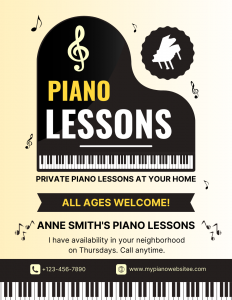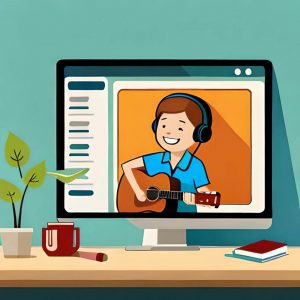 If you’re passionate about music and have the desire to share your knowledge with others, starting a career as a private music teacher can be a rewarding endeavor. Teaching music privately lets you connect with students personally and tailor your lessons to their needs and goals. In this guide, we’ll explore the benefits of becoming a private music teacher who gives at-home music lessons and provide actionable steps to kickstart your journey in teaching private music lessons at students’ homes.
If you’re passionate about music and have the desire to share your knowledge with others, starting a career as a private music teacher can be a rewarding endeavor. Teaching music privately lets you connect with students personally and tailor your lessons to their needs and goals. In this guide, we’ll explore the benefits of becoming a private music teacher who gives at-home music lessons and provide actionable steps to kickstart your journey in teaching private music lessons at students’ homes.
Here are seven tips to begin your career as a private music teacher, with a focus on at-home music lessons:
1. Embrace Competition: A Positive Sign
As you embark on your music teaching journey, it’s natural to feel intimidated by established music teachers in your local area. However, it’s essential to view competition as a positive sign. The presence of other music teachers indicates that there is a demand for music lessons, which is good news for you.
- Don’t be discouraged by the competition: Focus on setting yourself apart from competing music teachers, but resist the temptation to compete by price. For instance, if you’re competing with a big music school, instead of undercutting their prices, emphasize the personal touch you can provide. Large music schools often struggle with instructor turnover as many teachers leave due to low earnings after the school’s cut. You can differentiate yourself by committing to being your students’ stable and long-term music teacher.
- Know that there is a lot more demand than active students: Be aware that the demand for music lessons likely far exceeds the number of active students. Many potential music students are not taking lessons because they haven’t been able to find the right music teacher. This issue often arises from schedule conflicts, as they haven’t been able to locate a music teacher to accommodate their current schedule.
2. Consider the Advantages of Being a Traveling Music Teacher
A traveling private music teacher is a music teacher who provides in-home music lessons. This is one of the best ways to begin teaching music and offers you and your students many advantages.
- Cost-Effectiveness: Starting a music studio where students come to you can be costly. You’ll have to pay for rent, furniture, equipment, utilities, and permits. Opting to be a traveling teacher allows you to avoid the expenses of operating a physical studio, which is especially helpful when you begin your music teaching career.
- Higher Rates for Convenience: Traveling teachers can charge higher fees due to the added convenience of teaching at students’ homes, saving them time and effort. For busy parents, especially those with more than one child, driving to a music studio takes considerable time. When a teacher comes to their home, parents and other children can get things done while one child takes a lesson. Parents are happy to pay for such convenience.
3. Micro-Targeting: Reaching the Right Audience
One effective way to build your student base as an at-home music teacher is by micro-targeting the specific neighborhoods you’d like to give lessons. By following these steps, you can affordably market your music lessons to potential students in sought-after neighborhoods and foster word-of-mouth marketing to grow your clientele:
- Door Hangers and Flyers: Create simple flyers to advertise your music lessons. Include your availability and contact information. We’ve written an entire article about door-hanging flyers to market music lessons, but you don’t have to make it complicated or expensive. You can simply print flyers on your computer and pass them out in the neighborhoods you’d like to teach. Check the legalities of the neighborhoods you select to make sure you comply with soliciting laws.
- Neighborhood Selection: Focus on affluent neighborhoods with a significant number of children. While the neighborhoods you target don’t have to be extremely close to your location, consider the travel time to reach them. Prioritize having students who live close to each other to minimize travel time between lessons. This is more important than having the neighborhood itself close to your residence. This approach will enhance your efficiency as a traveling music teacher.
- Flexible Advertising: Use door hangers and flyers that can be easily updated to accommodate changing schedules and availability. If you have a Canva account, you can easily create a great-looking flyer that you can easily edit. The sample one below took 10 minutes to create on Canva.

4. Optimize Your Music Lesson Schedule
Efficient scheduling is crucial for a successful traveling music teacher. Here’s how you can make the most of your teaching hours:
- 45-Minute Lessons: Offer 45-minute lessons instead of 30-minute ones.This provides more teaching time and lets students settle into the lesson better. Every music lesson has an adjustment period during the first few minutes, where students and teachers get ready for the upcoming lesson. If it takes 5 minutes to get into the groove (pun intended), that only leaves 25 minutes for 30-minute lessons. However, if it’s a 45-minute lesson, there are still 40 minutes to teach, which is 60% more teaching time. You can charge extra for that.
- Strategic Lesson Booking: Schedule lessons in close proximity to each other to reduce travel time and maximize your teaching hours. While you cannot have one lesson immediately after the next due to travel time between students, you can still optimize the time between each lesson, especially if you offer 45-minute lessons. You can allot 15 minutes to get to the next student, which lets you schedule lessons at the top of each hour. The 15 minutes between students also has the added benefit of helping you keep your schedule. Many teachers who offer 30-minute lessons at their music studio discover that one late parent creates a domino effect of late lessons for the entire day. Having some padding between lessons helps to avoid that frustration.
5. Charge Higher Rates for At-Home Music Lessons
As a traveling music teacher, you offer personalization and convenience that other music teacher may not be able to match. Consider the value you provide when you set your music lesson rates:
- Premium Convenience: Price your lessons higher than studio-based teachers, considering the extra convenience you offer. A parent with two children taking 30-minute lessons at a music studio might have to spend 90 minutes out of their day. That’s assuming 15 minutes of travel time each way and two back-to-back 30-minute lessons. Contrast that with at-home lessons. You could teach each child for 45 minutes and the parent doesn’t have to spend any time dealing with it. The students get more lesson time, and the parent saves time and gas money.
- Communicate the Value: Clearly communicate the benefits of in-home lessons to justify the higher rates to potential students and their parents. In your music lesson marketing, explain that traveling to their homes helps parents save time and money.
6. Choose Profitable Neighborhoods: Expanding Your Reach
Don’t limit yourself to teaching only in your immediate vicinity. Consider branching out to neighborhoods that are slightly farther away but still within a reasonable travel distance. Here are the benefits:
- Wider Reach: Expanding your reach to nearby neighborhoods opens up more opportunities to find students. You might find large subdivisions with many families, which are prime for finding music students.
- Travel Time Management: If houses are close to each other, you can optimize your travel time between lessons.
7. Utilize Downtime: Productive Use of Gaps
Try as you might, you’re going to have downtime between students. Students will cancel lessons. Some students may need to shift their scheduled lessons because of conflicts with other activities, and other students will quit music lessons, even if you do everything right. You have to get good at managing and optimizing your downtime.
- Hang door flyers for your vacancies.
- Answer emails and leads for lessons.
- Send out a newsletter.
- Do bookkeeping for your business.
- Start a music teaching YouTube channel and edit videos for it.
- Work on your website.
- Work on your social media marketing.
- Write a blog post.
- Message students to encourage word-of-mouth marketing for your vacancies.
Just because you don’t have students during the time you’ve allocated to teaching doesn’t mean you have nothing to do. Spending that otherwise wasted time working on your business will save you time later.
Conclusion
Becoming a traveling music teacher offers numerous advantages, from cost-effectiveness to the ability to charge higher rates for your expertise and convenience. Embrace competition as a positive sign and focus on micro-targeting specific neighborhoods to grow your student base. Optimize your lesson schedule and use downtime wisely to further your business goals. By following these strategies, you can establish yourself as a successful private music teacher, enriching the lives of your students through the power of music.

 Do you want to get more students and grow your music teaching business?
Do you want to get more students and grow your music teaching business?